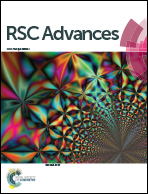Exploring the isomerization paths of push–pull hexatrienes†
Abstract
This computational study is an attempt to reveal the mechanism of the isomerization processes happening in donor (D)–acceptor (A) hexatriene systems. The photo-excitation of all-trans isomers of these conjugated systems with terminal donor (amine, methoxy) and acceptor (cyano) groups populates the first (S1) and second (S2) singlet excited states which correspond to transitions with reasonably high oscillator strength values. The S1 state of the amine (D), cyano (A)-substituted system forms a twisted and couple of slightly off-planar minima connected by low-energy transition states with configurations equally dominated by HOMO → LUMO and HOMO2 → LUMO2 excitations. Two important low-lying S0/S1 conical intersections have been identified in this system at 7–8 kcal mol−1 and 8–11 kcal mol−1 above the twisted excited state minima. The first one has been identified as the source of a cis–trans–trans isomer while the latter one may be responsible for the trans–cis–trans isomer. In comparison, the presence of a weaker donor group (methoxy) produces a more stable cis–trans–trans isomer from a lower energy S0/S1 conical intersection, situated around 20–23 kcal mol−1 below the vertically excited geometry. Both the isomers have an alternate thermal route of formation from the all-trans isomer through ground state transition states with activation energy values close to 50 kcal mol−1.


 Please wait while we load your content...
Please wait while we load your content...